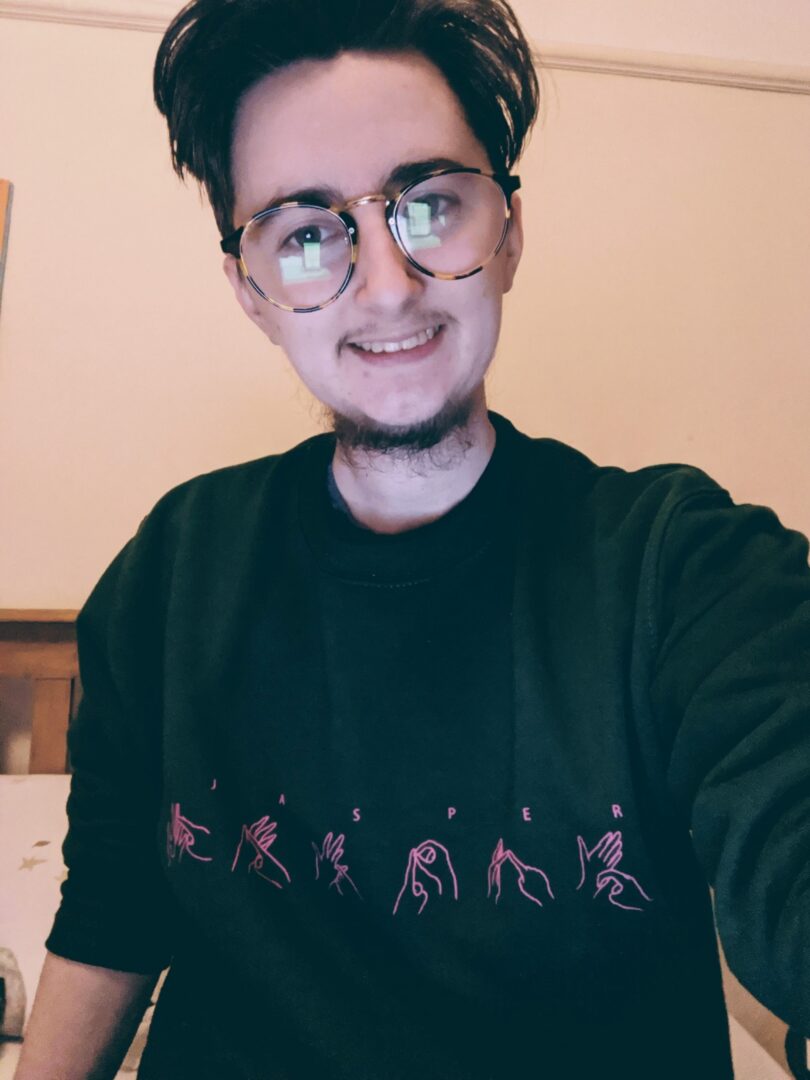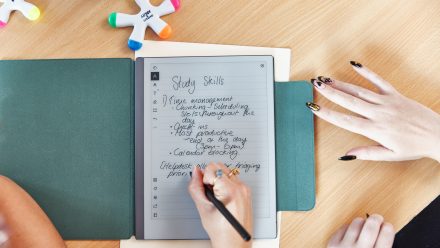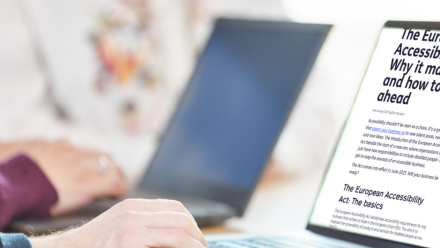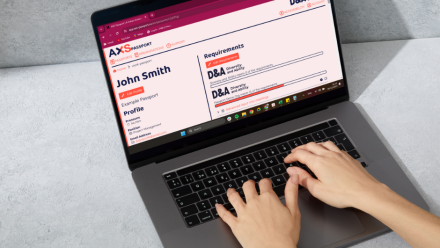Culturally and proudly Deaf: celebrating the Deaf community and the BSL Act on Deaf Awareness Week
4th May 2022 by Jasper Williams
I’m proud to be profoundly Deaf and a BSL user. My sign name is ‘badger’; sign names are a specific sign decided by a Deaf person so you can identify yourself without repeatedly fingerspelling your name using the BSL alphabet.
Being profoundly Deaf means that without my hearing aids, I cannot hear anything below 90 – 110 dB. Although I cannot hear in the same way as a Hearing person, I can just about hear some sounds like a motorbike, music concert, and sirens close by. It also means that I cannot hear conversations, background music, or TV. With my hearing aids, I can hear some sounds, so I am aware of my surroundings, but speech isn’t clear and I rely on BSL, facial cues, and other communication.

My audiogram, demonstrating my hearing levels in decibels
But don’t feel sorry for me. I am happy to be part of the Deaf community, and culturally, proudly, Deaf.
Historically, the Deaf community has had very few rights, partly from the impact of Alexander Graham Bell and the 1880 Milan conference, which attempted to eliminate sign language, as well as Deaf jobs and education. This has led to issues from having to use family instead of BSL interpreters at appointments, the government not providing BSL interpreters, and cultural appropriation of sign language. However, finally, on April 27th 2022, the British Sign Language (BSL) Bill passed its third reading unopposed, meaning that when the Queen formally agrees to make the bill law (royal assent) the BSL Act will come into effect!
British Sign Language (BSL) is the sign language used in the UK, and for many in the Deaf community, it is our preferred language. BSL is separate from other sign or spoken languages with its own grammar structure and syntax. Out of 151,000 people who use BSL, it is estimated that there are 87,000 Deaf BSL users. Although BSL was ‘recognised’ as an official language in 2003, BSL has not had the same legal protections as other languages.
The BSL Act means that there will be legal recognition of BSL as a language in England, Wales and Scotland, the same as spoken English, Welsh, and Gaelic.
But that’s not it!
The Act imposes a legal requirement for government departments to report on how they are promoting BSL as a language. There will also be a BSL Advisory Board of BSL signers, who will provide guidance for public services on how BSL users’ needs should be met. Part of this guidance will be to the DWP on increasing the number of BSL interpreters and reviewing the Access to Work provision.
This is just the beginning of the campaign, and there’s a long way to go – the Act only gives rights to BSL, not to Deaf people – but it is a tremendous achievement and a great start.
Currently, Deaf people face lots of barriers due to societal attitudes and exclusion, for example:
- Misconceptions remain about how a Deaf person can communicate and their level of intelligence. In the past, employers have thought I couldn’t do certain tasks and therefore they’ve refused to pay for access support.
- Inaccessible healthcare. Healthcare services often fail to provide BSL interpreters and frequently reschedule, or even cancel essential appointments. The lack of interpreters and delays means that often, as a last resort, the responsibility is put onto friends or family who can sign. It’s both unfair to the person interpreting and, more crucially, takes away my independence and right to have a confidential healthcare appointment. This is not an isolated situation.
Through the pandemic, it has been hard. While lipreading is useful and important for some, there are still many Deaf people (like me!) who cannot understand lipreading alone, meaning that having your face visible and clear is not always enough to help interaction. Lipreading is a tool used in combination with others such as facial expressions, body language, and writing things down. Having the face visible is not always for lipreading; without the mouth, I can’t see facial gestures or lip patterns, crucial parts of BSL and nonverbal communication.

For me, BSL was lifesaving. Before, I couldn’t communicate with my friends, my family, and the world around me. It was isolating and I didn’t know any Deaf people at the time. This didn’t hold me back; I threw myself into the Deaf community, getting help from the British Deaf Association (BDA)’s Deaf Roots and Pride mentoring scheme, learning BSL and attending regular Deaf events. I became an active and proud member of the Deaf community and BSL became my preferred language. It meant that I had access to a whole new community I could communicate and relate to, a shared culture and history.
Top tips for communicating with a Deaf person
- Find a BSL course and start to learn! For online courses, BSL Courses is a great resource, and you can also find local BSL courses that are accredited (but make sure you have a Deaf tutor!) at Signature or iBSL.
- Get attention before you start communication, such as waving your hand
- Remember everyone has their own needs and preferences. Check with each person how they would like to communicate with you
- Position yourself in front of the person, with good lighting and reduce any noise.
- Keep things simple with the most important topic first with one point at a time
- Gesture or use visual cues if you can.
- Be patient and understanding; instead of giving up, think about other communication methods you could use such as writing things down.
- Consider how you can use apps on your phone to aid communication, such as:
- Live transcription: Otter AI, Live Transcribe (Apple or Android), Text Hear (Apple) and Speech Notes (Android)
- Notes/typing conversation: Note Listen for Deaf (Apple), Deaf Note (Android), Make It Big (Apple or Android), Big Word (Apple or Android), Cardzilla
- BSL apps: SignBSL, Bright BSL help if you are trying to find a specific sign
Happy Deaf Awareness Week!
Some links that were no longer active, including references, have been removed from this blog post. If you have any questions or concerns please contact us.
- Share:
- Share Culturally and proudly Deaf: celebrating the Deaf community and the BSL Act on Deaf Awareness Week from D&A | Diversity and Ability on LinkedIn
- Share Culturally and proudly Deaf: celebrating the Deaf community and the BSL Act on Deaf Awareness Week from D&A | Diversity and Ability on Twitter
- Share Culturally and proudly Deaf: celebrating the Deaf community and the BSL Act on Deaf Awareness Week from D&A | Diversity and Ability via Email
- Share Culturally and proudly Deaf: celebrating the Deaf community and the BSL Act on Deaf Awareness Week from D&A | Diversity and Ability on Facebook


